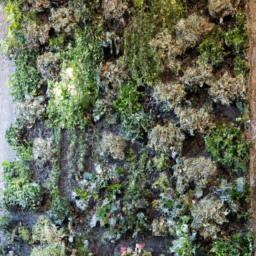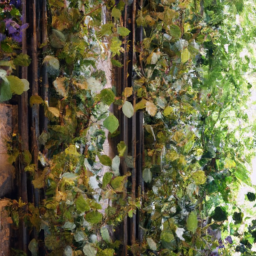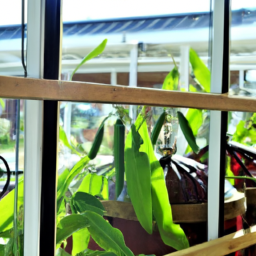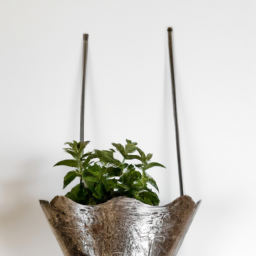
Do you ever feel like your walls are missing something? Well, look no further! In this blog post, we will explore the fascinating world of vertical greenery and how you can utilize your walls for stunning plant displays. Vertical greenery, also known as living walls or green walls, is a growing trend that brings the beauty of nature indoors. Whether you have limited space or simply want to add a touch of green to your home or office, vertical greenery offers a creative and innovative solution. So, let’s dive in and discover the endless possibilities of transforming your walls into living works of art with vertical greenery!
Benefits of Vertical Greenery: Exploring the Advantages of Utilizing Walls for Plant Displays
Welcome to this comprehensive guide on vertical greenery and how it can transform your walls into stunning plant displays. In this article, we will delve into the numerous benefits of utilizing walls for plant displays, providing you with an insightful perspective on this innovative and eco-friendly approach. So, let’s embark on this green journey together!
Enhancing Aesthetics and Visual Appeal
One of the primary advantages of vertical greenery is its ability to enhance the aesthetics and visual appeal of any space. By transforming bare walls into lush green canvases, vertical gardens create a captivating and refreshing ambiance. The vibrant colors, textures, and shapes of various plant species add depth and character to otherwise dull walls, making them visually pleasing and inviting.
Furthermore, vertical greenery allows for creative expression and customization. You can choose from a wide range of plant species, each with its unique foliage and growth patterns. Whether you prefer a tropical paradise, a serene Zen garden, or a modern minimalist design, vertical greenery offers endless possibilities to suit your personal style and preferences.
Moreover, the presence of greenery has been scientifically proven to improve mood and reduce stress levels. The calming effect of plants can create a soothing and relaxing environment, benefiting both your physical and mental well-being. With vertical greenery, you can effortlessly bring nature indoors, fostering a tranquil oasis in the midst of urban settings.
Improving Air Quality and Reducing Noise
Vertical greenery plays a vital role in improving air quality, particularly in urban areas where pollution levels are high. Plants act as natural air purifiers, absorbing harmful pollutants and releasing oxygen through the process of photosynthesis. By incorporating vertical gardens into your walls, you can contribute to reducing air pollution, creating a healthier and cleaner environment for all.
Additionally, vertical greenery helps to combat the urban heat island effect. The evapotranspiration process of plants cools the surrounding air, mitigating the heat absorbed by buildings and pavement. This cooling effect can significantly lower energy consumption and reduce the need for air conditioning, leading to cost savings and a more sustainable urban ecosystem.
Another advantage of vertical greenery is its ability to act as a natural sound barrier. The foliage of plants absorbs and diffuses sound waves, reducing noise pollution and creating a more peaceful atmosphere. Whether you live near a busy road or work in a bustling office, incorporating vertical greenery can help create a serene and productive environment.
Maximizing Space Efficiency and Biodiversity
Vertical greenery is an excellent solution for maximizing space efficiency, especially in urban areas where land is limited. By utilizing walls for plant displays, you can transform unused vertical surfaces into thriving gardens, making the most of every available space. This is particularly beneficial for those living in apartments or working in offices with limited floor area.
Furthermore, vertical greenery promotes biodiversity by providing a habitat for various plant species. Urban environments often lack green spaces, leading to a decline in biodiversity. Vertical gardens act as miniature ecosystems, attracting birds, butterflies, and other pollinators, thus enhancing the ecological balance and contributing to the overall well-being of the environment.
Moreover, vertical greenery offers the opportunity to grow edible plants and herbs, promoting sustainable and locally sourced food production. Imagine having fresh herbs right at your fingertips, ready to enhance your culinary creations. With vertical gardens, you can cultivate your own mini urban farm and embrace a more sustainable lifestyle.
In conclusion, vertical greenery provides numerous benefits, from enhancing aesthetics and improving air quality to maximizing space efficiency and promoting biodiversity. By utilizing walls for plant displays, you can create visually stunning and eco-friendly environments that have a positive impact on your well-being and the planet. So, why not embark on this green journey and transform your walls into vibrant and sustainable works of art?

Designing Vertical Greenery Systems: Tips and Techniques for Creating Stunning Plant Displays on Walls
Welcome to the world of vertical greenery! In this guide, we will explore the art of utilizing walls for plant displays, providing you with tips and techniques to create stunning green walls that will transform any space into a vibrant oasis. Whether you are a gardening enthusiast or a professional designer, this step-by-step guide will help you bring life to your walls in an engaging and unique way.
Understanding Vertical Greenery
Vertical greenery, also known as green walls or living walls, is a technique that involves growing plants vertically on walls or other vertical surfaces. This innovative approach not only adds beauty and visual interest to any space but also offers numerous environmental benefits. Green walls can improve air quality, reduce noise levels, regulate temperature, and enhance biodiversity.
When designing a vertical greenery system, it is essential to consider the specific needs of the plants you choose. Factors such as sunlight exposure, water requirements, and plant compatibility should be taken into account. Additionally, the structural integrity of the wall and the availability of irrigation systems should also be considered.
Choosing the Right Plants
When selecting plants for your vertical greenery system, opt for species that are well-suited to vertical growth. Some popular choices include ferns, succulents, ivy, and flowering vines. These plants are known for their adaptability and ability to thrive in limited soil conditions.
Consider the lighting conditions of the wall where you plan to install the greenery. If the wall receives ample sunlight, choose plants that can tolerate direct sunlight. If the wall is shaded, opt for shade-loving plants. It is crucial to match the plants’ light requirements with the available conditions to ensure their healthy growth.
Furthermore, take into account the maintenance requirements of the chosen plants. Some plants may require regular pruning or watering, while others are more low-maintenance. Choose plants that align with the level of care you are willing to provide.
Installation and Maintenance
Before installing your vertical greenery system, prepare the wall by ensuring it is clean and free from any debris. It is advisable to install a waterproof membrane or a protective layer to prevent water damage to the wall. Additionally, consider installing an irrigation system to ensure proper watering of the plants.
Begin by attaching a trellis or a wire mesh to the wall to provide support for the plants. This will allow the plants to climb and grow vertically. Make sure the trellis or mesh is securely fastened to the wall to withstand the weight of the plants as they grow.
Next, carefully plant the selected greenery at the base of the wall, ensuring each plant has enough space to grow and thrive. Consider the growth habits of the plants to determine the appropriate spacing between them. As the plants grow, regularly monitor their progress and make adjustments as needed.
Maintenance is a crucial aspect of keeping your vertical greenery system healthy and vibrant. Regularly inspect the plants for pests or diseases and take appropriate measures to prevent or treat any issues. Water the plants according to their specific needs and fertilize them as necessary. Prune any overgrown or damaged foliage to maintain the desired appearance.
Enhancing the Visual Appeal
Creating stunning plant displays on walls goes beyond the selection and installation of plants. Consider incorporating additional elements to enhance the visual appeal of your vertical greenery system. Add decorative elements such as hanging baskets, planters, or artwork to create a unique and personalized display.
Experiment with different plant arrangements and colors to create a visually striking composition. Combine plants with contrasting textures, heights, and foliage colors to add depth and interest to the green wall. Additionally, consider incorporating fragrant plants to stimulate the senses and create a delightful atmosphere.
Regularly maintain and groom your vertical greenery system to ensure its long-term beauty. Remove any dead or wilted foliage promptly and replace them with healthy plants to maintain a lush and vibrant appearance. With proper care and attention, your vertical greenery system will continue to thrive and captivate for years to come.
Now that you have learned the tips and techniques for designing stunning plant displays on walls, it’s time to unleash your creativity and bring life to your vertical spaces. Whether it’s a small balcony, a large backyard, or an office lobby, vertical greenery has the power to transform any space into a green oasis. Get started today and enjoy the beauty and benefits of vertical greenery!

Vertical Greenery: Utilizing Walls for Plant Displays
Welcome to the world of vertical greenery! In this guide, we will explore the fascinating concept of utilizing walls for plant displays. Vertical greenery not only adds beauty and aesthetics to your surroundings but also offers numerous environmental benefits. So, let’s dive in and discover how to create stunning plant displays on walls.
Choosing the Right Plants
When it comes to vertical greenery, selecting the right plants is crucial. Consider the environmental conditions of the wall, such as sunlight exposure and wind patterns. Opt for plants that thrive in those conditions. Some popular choices for vertical greenery include ferns, ivy, succulents, and flowering vines.
It’s important to choose plants with similar growth requirements to ensure they will thrive together. Pay attention to their water and nutrient needs, as well as their compatibility in terms of growth rate and size. This will help create a harmonious and visually appealing display.
Additionally, consider the maintenance requirements of the chosen plants. Some plants may require more frequent pruning or specialized care. By selecting low-maintenance plants, you can ensure that your vertical greenery remains beautiful without excessive effort.
Preparing the Wall
Before installing your vertical greenery, it’s essential to prepare the wall properly. Start by cleaning the surface to remove any dirt, debris, or loose paint. This will provide a clean and stable foundation for the plants to grow. If necessary, repair any cracks or damages to the wall.
Next, consider the structural support required for your plant display. Depending on the size and weight of the plants, you may need to install a trellis, wire mesh, or a specialized vertical garden system. Ensure that the support structure is securely attached to the wall and can withstand the weight of the plants as they grow.
Additionally, consider the water drainage system. Incorporate a waterproof membrane or a drainage layer to prevent water damage to the wall. This will also help maintain a healthy environment for the plants by preventing waterlogged soil.
Planting and Maintenance
Now that your wall is ready, it’s time to plant your chosen greenery. Begin by preparing the soil or growing medium. Use a lightweight and well-draining mixture that provides adequate nutrients for the plants. Ensure that the soil or growing medium is evenly distributed and packed securely in the planting pockets or containers.
When planting, take into account the growth habit of each plant. Place taller plants towards the bottom and shorter ones towards the top to create a visually appealing arrangement. Allow enough space between the plants to accommodate their growth without overcrowding.
Regular maintenance is essential for the long-lasting beauty of your vertical greenery. Water the plants regularly, taking care not to overwater or underwater them. Monitor the moisture levels in the soil and adjust the watering frequency accordingly. Fertilize the plants as needed, following the recommended guidelines for each species.
Pruning is another crucial aspect of vertical greenery maintenance. Trim and shape the plants to maintain their desired size and appearance. Remove any dead or diseased foliage promptly to prevent the spread of pests or diseases. Regularly inspect the plants for signs of stress or nutrient deficiencies and take appropriate action.
Lastly, keep an eye out for any pests or diseases that may affect your vertical greenery. Early detection and treatment are essential to prevent damage to the plants. Use organic pest control methods whenever possible to minimize the impact on the environment.
By following these steps and implementing proper care and maintenance practices, you can create stunning and long-lasting plant displays on walls. Vertical greenery not only enhances the visual appeal of your surroundings but also contributes to a healthier and more sustainable environment. So, let your creativity bloom and enjoy the beauty of nature on your walls!
Recap of this article
Vertical greenery, also known as vertical gardens or living walls, is a creative and innovative way to bring nature into urban spaces. It involves utilizing walls as a canvas for plant displays, transforming dull concrete surfaces into lush and vibrant greenery. Not only does this concept add beauty and aesthetic appeal to our surroundings, but it also offers numerous environmental and health benefits.
Vertical greenery has gained popularity in recent years due to its ability to maximize limited space and improve air quality. By covering walls with plants, we can create a more sustainable and eco-friendly environment. These living walls act as natural air filters, absorbing pollutants and releasing oxygen, thus reducing air pollution and improving the overall air quality. Additionally, vertical gardens help to regulate temperature, reducing the urban heat island effect and creating a more comfortable and pleasant atmosphere.
Apart from the environmental advantages, vertical greenery also has positive impacts on our well-being. Being surrounded by greenery has been proven to reduce stress levels and improve mental health. The sight of plants and the connection with nature have a calming effect, promoting relaxation and tranquility. Moreover, vertical gardens can provide insulation, reducing noise pollution and creating a quieter and more peaceful environment.
In conclusion, vertical greenery is a fantastic way to enhance our living spaces by utilizing walls for plant displays. It not only beautifies our surroundings but also improves air quality, regulates temperature, and promotes well-being. By incorporating vertical gardens into urban areas, we can create a greener and healthier environment for everyone to enjoy.
Curious Minds Asked, We Responded. Frequently Asked Questions:
Q1: What is vertical greenery and how does it utilize walls for plant displays?
A1: Vertical greenery refers to the practice of growing plants vertically on walls or other vertical surfaces, creating a living green wall. It involves using specialized systems that allow plants to grow vertically, such as planters or modular panels. By utilizing walls for plant displays, vertical greenery maximizes limited space and brings nature into urban environments, enhancing aesthetics, improving air quality, and providing other benefits.
Q2: What are the benefits of utilizing walls for vertical greenery?
A2: Utilizing walls for vertical greenery offers several benefits. Firstly, it helps to beautify urban spaces by adding a touch of nature and greenery to otherwise dull walls. Secondly, it improves air quality by absorbing pollutants and releasing oxygen. Vertical greenery also provides insulation, reducing heat absorption and energy consumption. Additionally, it can help reduce noise pollution and create a more pleasant and calming environment.
Q3: What types of plants are suitable for vertical greenery on walls?
A3: Various types of plants can be used for vertical greenery, depending on factors such as the climate, available light, and the specific system used. Some popular choices include ferns, mosses, succulents, ivy, and other climbing plants. These plants are often selected for their ability to thrive in vertical environments, adaptability to different light conditions, and low maintenance requirements.
Q4: How do you maintain vertical greenery on walls?
A4: Maintaining vertical greenery involves regular care and attention. It typically includes tasks such as watering, pruning, fertilizing, and monitoring for pests or diseases. The frequency of maintenance depends on factors like the plant species, climate, and the specific system used. Many vertical greenery systems incorporate irrigation systems or self-watering mechanisms to simplify watering. It’s important to follow the specific care instructions provided by the system manufacturer or consult with a professional for proper maintenance practices.
Q5: Can vertical greenery be installed indoors?
A5: Yes, vertical greenery can be installed indoors, bringing the benefits of nature and greenery into indoor spaces. Indoor vertical greenery systems are designed to accommodate the unique conditions of indoor environments, such as lower light levels and controlled climates. These systems often incorporate artificial lighting and irrigation systems to provide the necessary conditions for plant growth. Indoor vertical greenery can be a great way to improve indoor air quality, enhance aesthetics, and create a healthier and more pleasant environment.

Lisa Chen is a seasoned indoor gardening expert and the author of several bestselling books on the topic. With a background in horticulture and urban farming, Lisa is dedicated to helping urban dwellers embrace the joys of cultivating green spaces indoors. Her detailed guides and hands-on tips empower readers to transform their living spaces into thriving plant sanctuaries.


